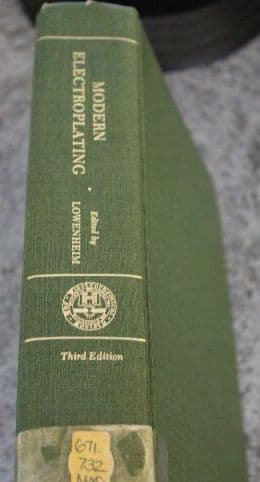
Curated with aloha by
Ted Mooney, P.E. RET

The authoritative public forum
for Metal Finishing 1989-2025

-----
Black Stains when Brass electroplating onto plastics
Q. I have problems to plate plastics with brass. First I plate copper to the plastics and then the brass, but after I plate with brass there are many black spot on the product. Does anyone have opinion for this case?
Kusuma P [last name deleted for privacy by Editor]- Bandung, West java, Indonesia
A. Kusama,
You need to plate nickel after the copper, because it is the correct method for plating brass on any surface not only on plastics. So, copper, bright nickel, and afterwards brass.
Good luck,
Rafael A [last name deleted for privacy by Editor]- Caracas, Venezuela
A. Dear sir,
Please specify whether after brass plating on copper surface, you are using a lacquer also on the brass surface? Because brass has the property of getting tarnished very quickly with time in contact with environmental factors viz. moisture, temp, etc., you find black spots on the brass surface. So to protect the brass coating give the plated material a dip in lacquer.
Good luck,
Sandeep J [last name deleted for privacy by Editor]- New Delhi, India
A. Hi. There are many different ways to plate plastic, depending on how high quality and robust the plating must be. Plating of automobile exterior plastics, for example, is much more difficult and much more robust than plating strictly for decorative effect with no wear or exposure. Please see our FAQ on Metallizing Non-conductive Items if interested in that.
But the robust method involves electroless nickel plating anyway. So electroless nickel plating followed by brass plating may be ideal. Sandeep is right, of course, that the brass plating will still tarnish if not lacquered or clear coated. But most brass plating solutions are cyanide based and cyanide staining is a perennial problem perhaps best solved in this case by alternate hot and cold rinsing. Good luck.
Regards,

Ted Mooney, P.E.
Striving to live Aloha
finishing.com - Pine Beach, New Jersey
January 2014
Decorative Brass Plating on plastics or resin query
July 1, 2016Q. To Forum members and experts,
I have inherited a plating line in a company I now own and it currently plates in copper, nickel , silver and gold. They do a decent job of it and the quality is acceptable for the spec that is requested by the customers.
We now need to do brass plating and the long time head of the plating dept has left the business due to personal circumstances before my time and recently was in a auto accident and was killed and none of the current staff seem to know or understand how to set up a bath for brass plating.
My question is would anyone be able to advise or guide me on the recipe for that bath, and/or any other specifics in order to plate brass. I can not find any recipes or instructions on line that a layman can understand like myself . Further they have done and still do some plating on fiberglass by spraying copper powder on the part (it literally comes off on your fingers) then putting a copper strike onto that, then proceeding with nickel plate the gold or silver. I know this cannot be a good method; I would presume adhesion is poor though it appears that they have gotten away with it for some time, so I might also ask what is proper way or material needed to plate on fiberglass or resin parts, to make them conductive.
I would appreciate any guidance or advice from the forum.
Regards,
edward
owner - Morganton North Carolina USA
July 2016
A. Hi Edward. I'm confident that people will be pleased to try to help you, but realistically you probably should bring in a plating consultant if your people don't know the subject.
Every electroplating textbook that I know of includes a chapter on brass plating. Most brass plating baths are cyanide based, which means you'll be introducing a powerful poison to your shop that you are not familiar with (unless your silver plating is cyanide based). I would not introduce cyanide without hands-on instruction. There are some cyanide-free proprietary brass plating baths, and you could investigate that.
Brass is usually plated on top of nickel plating; I don't know if you were planning on that. It is also possible to do brass-toned electrophoretic lacquer instead of actual brass plating, but this requires somewhat different equipment.
There are many ways of metallizing plastic. Spraying copper powder probably offers far less adhesion than some other methods, but even here the adhesion is probably much better if the parts have been properly cleaned and pre-treated than if unprepared parts are simply sprayed.
Regards,

Ted Mooney, P.E. RET
Striving to live Aloha
finishing.com - Pine Beach, New Jersey
Q. Thanks and, yes, their silver bath is the nasty stuff but they pay a firm to dispose of it properly and respect it carefully in the plating plant. Look forward to any and all advice ... which book is a good choice ? Thanks --Ed
edward sasser [returning]- morganton North Carolina USA
July 4, 2016
sometimes on
AbeBooks or Amazon
(affil links)
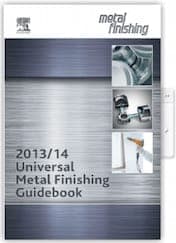
free pdf is currently available from academia.edu
A. Hi again. Modern Electroplating is a pretty good one, and has a chapter on brass plating specifically as well as a chapter on alloy plating in general. The Metal Finishing Guidebook is good too.
Regards,

Ted Mooney, P.E. RET
Striving to live Aloha
finishing.com - Pine Beach, New Jersey
July 31, 2016
Q. Hi Everyone,
I have attached some photos of a workpiece I am trying to end up plating in brass. The first two shots show it with the antique finish applied. The third shot shows it before buffing it out or in raw state . You can see where inside the form the area that did not plate ... it's kind of grey-ish color or white up in the shadow of the piece.
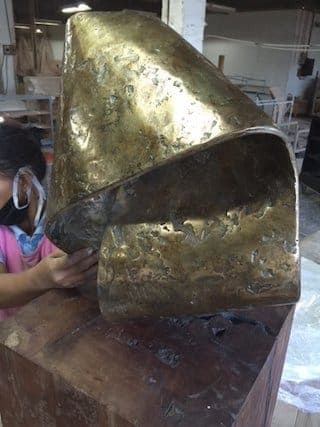
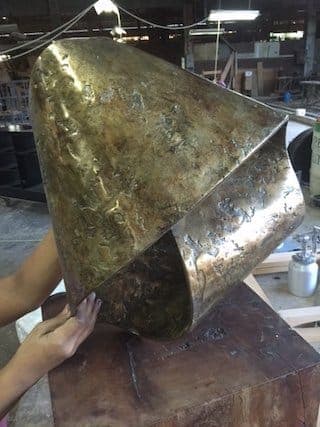
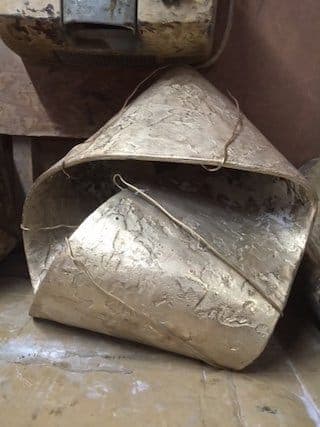
The shape is causing us a real headache ... first, the piece is fiberglass and sprayed in copper paint as was previously suggested. It plates well enough on outside and 70% of the inside but a few areas inside will nor plate. The piece is about 16 inches tall and wide and about 8 inches deep (my staff's hand can be seen to give a better idea of scale).
Any ideas, advice and /or comments, etc. are welcome.
Thanks
Ed
- morganton North Carolina USA
A. Hi Edward. According to Faraday's Law, the plating goes where the current goes; but the current more or less takes the shortest path. You need "auxiliary anodes" to get good coverage on the interior of the piece. That means either anode material connected to the anodic current, or pieces of stable metal attached to the anode, and positioned in that "shadowed area" so the anode is closer to it than to anything else.
The best decorative effect is probably achieved by plating with the auxiliary anodes first, then going through the plating tank a second time with only the tank anodes.
Regards,

Ted Mooney, P.E. RET
Striving to live Aloha
finishing.com - Pine Beach, New Jersey
August 2016
Q. Wow, thanks Mr Mooney ... great idea will try ASAP. Since the piece is in motion or being agitated normally when plating, I assume I would use that anode in the interior position inside while still to get the plating on first, then run it as normal? I have to do over a 140 pcs so I am eager to try.
More comments welcome!
Cheers ED
- morganton North Carolina USA
August 1, 2016
A. Hi again. It is possible to build the auxiliary anodes right into your plating jig/rack, so they are agitated with the rack, and just connect a jumper cable from an auxiliary anode connection point on the jig to the anode bar to allow rack agitation. But it's up to you to figure out what is the easiest method that works :-)
If the only plating you are doing is cyanide brass, the auxiliary anode can probably just be steel, taped or plastisol coated except where you want it exposed. If you are doing an underlayer of nickel plating, you'll need something more exotic like nickel.
Regards,

Ted Mooney, P.E. RET
Striving to live Aloha
finishing.com - Pine Beach, New Jersey
August 2016
Q. Hi Mr Mooney , I don't think I was clear on my system. I plate in copper over the copper paint, or the copper plate first; then buff and smooth out the copper plate if need be (it's normally a bit rough); then nickel plate and then brass plate. So I was bit confused on your last comment of using steel ... would that not mean the steel is plating onto the copper paint? I am currently plating copper with big copper solid round bar as the anodes, nickel the same and bars of extrusion stock for brass plating. Any comments here?
As a side query, I like the idea of plating in steel over the fiber glass too like I am doing the brass. What kind of recipe for the bath is needed for that? I assume too the same process, metallic copper paint first on fiber glass, then copper plate , then nickel, and then the steel?
Starting to have real fun with this....
thanks ED
- Morganton North Carolina USA
August 1, 2016
A. Hi. Again, you really should retain a plating consultant or at least get the supplier of your plating solutions to visit and advise on proper use. Electroplating is a hundred year old trade and you don't need to do absolutely everything by trial and error. We may have been misunderstanding each other, but people don't usually make up plating baths from raw commodity chemicals, they buy the plating solutions from plating industry suppliers.
No, you won't plate out steel if you connect steel to the anodes in a cyanide brass plating bath. But iron plating is significantly more difficult than copper, nickel, or brass; I would not suggest it. Your anode materials are not ideal, but if they're working after a fashion, I guess you can concentrate on more pressing things.
Regards,

Ted Mooney, P.E. RET
Striving to live Aloha
finishing.com - Pine Beach, New Jersey
August 2016
Q, A, or Comment on THIS thread -or- Start a NEW Thread
